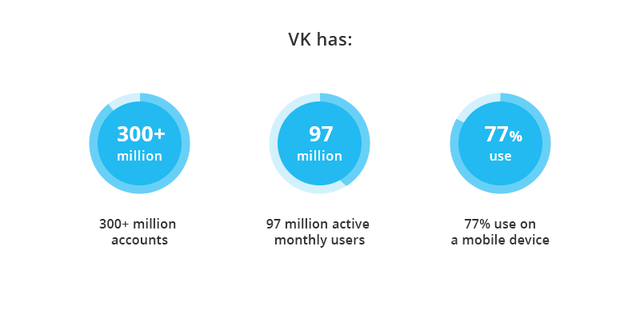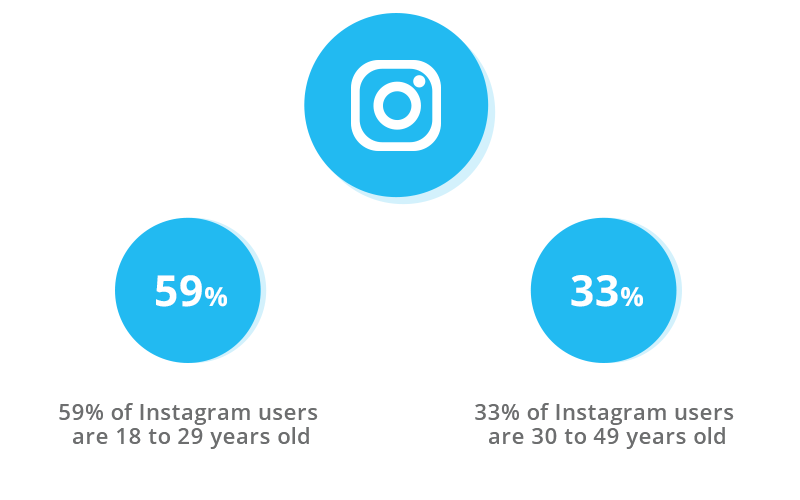Come and see us at IBC!
We’re delighted to once again be exhibiting at the annual IBC event at the RAI in Amsterdam. We’ll be there from Friday 14th through to Tuesday 18th September, meeting our current and future partners.
Last year we presented our video production platform’s refreshed interface and a set of brand new features. Since last year we’ve advanced our platform considerably and worked in collaboration with our partners to make this happen. At this year’s International Broadcasting Convention we’ll be launching some amazing new products and announcing exciting partnerships.
If you want to know more, simply visit our booth at IBC. You can find us in Hall 14 on Stand B15. If you’re not planning to be there, tune in to our launches and announcements on social media, where we’ll provide on-going updates from the event.
After IBC, if you’d like to find out more, simply drop us a line at meet@tellyo.com, or simply message us through our contact form.
How to reach Russian sports fans during the FIFA World Cup 2018?
When it comes to the web, Russia is a well-connected super power. It boasts the biggest internet nation in the whole of Europe – a whopping 76% of its citizens are online, which equates to nearly 110 million users. Most of them are using Vkontakte social media platform.
Russia is a market probably unlike anything you know – where Facebook and Google are not the first choice for users; where audiences still love western brands and have a huge appetite for great video content.
With the FIFA World Cup just weeks away, the key to success is VKontakte (VK) – Russia’s answer to Facebook. But what exactly is VK and why do Russians prefer it over other social channels? How can you create a presence on VKontakte (VK) and get more followers for your brand?
Download our e-book to learn for yourself. It’s your essential guide to reaching Russian sports fans during the FIFA World Cup 2018.
Download our e-book here
Ideas for online video content when you can’t show games
Thanks to deals between sports leagues and broadcasters, games are now accessible all over the world. Fans can watch Premier League games in Los Angeles or the Super Bowl in Mumbai – and have become accustomed to the luxury of watching their team on TV or via a streaming service.
For many clubs, they’re unable to stream games on their own social media channels because the rights are in the hands of a league or federation. Yet the huge growth in digital viewing behaviours and the appetite for online video means that clubs are often left wondering how they can get involved. For those fans unable to watch live games at a stadium, or pay for a TV/streaming service, there’s often not much content left for them to enjoy.
Check out our other stories:
- The most common live video streaming habits of digital audiences
- Still looking for a prime alternative to Snappy TV?
But this situation for both clubs and fans can be changed very easily. If you’re part of a club, here’s a list of content ideas you can use to generate great video content, and keep your fans engaged, well informed and bonded to your club community.
Press conferences – before and after games
Fans like to hear why their team lost or know how the dressing room feels after winning. What influenced the coach to use a particular strategy, or why did they wait so long to make a crucial substitution. How are preparations going for the next game? The best way to give your fans all the answers they need is by broadcasting your press conferences.
Injury updates
In sport, injuries are part of life. But when it happens to a key player, fans get really worried. Back in 2006, Leo Messi suffered a metatarsal fracture that ended in 87 days off and him missing 18 games[1]. Imagine how Barca fans would feel if it happened again. That’s why regular injury updates, interviews with doctors and reports on the recovery process are a great source of information for fans.
Other teams’ matches
While fans are often focused on a club’s main team, many clubs have much more to show: a women’s team, the second team and youth academy teams. These games also present huge opportunities and will be of interest to many fans.
Stadium tours
For those of fans unable to visit the stadium, an online tour might not substitute a real trip but it is the next best thing. You could show some of the most important places for the team: the locker room, trophy galleries and entrance onto the pitch, as well as fan areas and the press box.
This kind of video tour can also act as a commercial to attract fans to visit the stadium more often and as a way to market to potential buyers of hospitality boxes.
Pre-season games
Pre-season games are a chance to show how new players are performing and for fans to check out any changes in formation. It is an exciting time for fans who have been looking forward to seeing games after weeks off in between seasons.
Presentations
Everything that happens at a club is interesting for its core supporters. It’s worth sharing club moments with fans, such as the signing of new player, the promotion of a youth academy player to the first team, or the presentation of a new kit. There will be lots more ideas you can come up with.
Player challenges
A great way to entertain fans is to organise challenges, so players can show off their skills (or lack of them!). If you need ideas, simply look on YouTube as it’s amazing how many great ideas you can find for this kind of competition.
Match day preparations
This can be really nice for fans, especially for the most important games of the season, such as the first home game, a playoff, derby match or even a final. If you don’t have rights to the actual game, you might show your team’s pre-game routine: their breakfast, the trip to the stadium, warm ups and any final preparations before kick off.
Community events
If your club is active in your local community, this is also something that’s worth sharing. Whether it’s a tournament for your youngest fans, or a festival-style event that brings players and fans together.
Fans asking, players responding
This is something many fans like to do – to ask their favourite players about their life and career. You might collect questions via social media and ask your players or training staff to answer them. Remember: this doesn’t have to be 100% serious! The more fun to watch, the better the results will be.
‘Season in a minute’ summaries
It’s great to show your supporters an end of season summary. Whether it’s been full of ups and downs, or a season of trophies, it’s nice to show some extras.
Even if you’re unable to stream club games, there are plenty of things you can show your fans. You just need to stay open to ideas and look around at life in your club. Creating and sharing video content will not only positively influence your marketing efforts, but will keep your fans even more engaged. It’s worth a shot!
[1] https://www.transfermarkt.com/lionel-messi/verletzungen/spieler/28003
How Facebook is creating its own sports streaming service and what we can all learn from it
In August 2017, when Facebook launched its video platform – Facebook Watch – it was a bold move to target the huge growth in online video consumption. Video is by far the most engaging content type[1]. It’s also relatively easy to monetise. So Facebook Watch is no great surprise, as it provides the social media giant with an on-demand service for longer-form video content and a space to promote its own video productions.
Facebook’s reasoning is actually very clear: People love watching video and Facebook wants to earn money from adverts shown in those videos. But, while Facebook has made it super easy to stream and publish videos on their platform – and with consumption still growing – there has never been one central place to find video content on the platform.
To find video content, Facebook users have to scroll down their feeds or use the search feature (which is far from useful when it comes to video search). Facebook has been aware of these limitations for some time – realising it’s not good enough if they want to be a serious player in the video market and why people still prefer to watch videos on YouTube or via on-demand services.
With Watch (released only in US so far), Facebook now has a go-to central area where users can easily find video content, which Facebook hopes will rival the likes of YouTube.
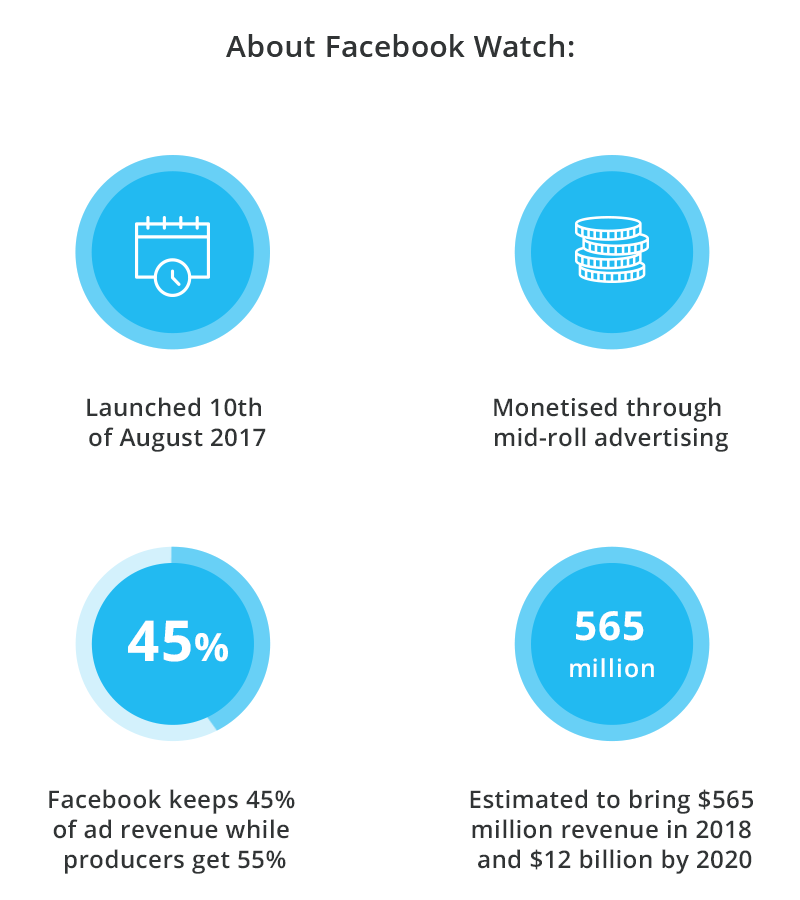
What’s inside Facebook Watch?
Video is not going to disappear from a user’s feed, but with Facebook Watch there will be more professional productions served in a better way. Watch’s menu is mostly a mix of comedy, documentaries, reality shows and documentary series dedicated to sports. The latter include shows like:
- Ball in the Family – dedicated to talented basketball players within Ball family and its notorious patriarch, LaVar. See how Ball’s family build their popularity with their video appearances here.
- Behind the Wall – showcasing NASCAR driver Bubba Wallace’s preparations for the Daytona 500 race.
- Bill Murray & Brian Doyle-Murray’s Extra Innings – which follows everyone’s favourite Bill Murray and his brother Brian Doyle-Murray, visiting Minor League ballparks where they explore small but strong communities dedicated to baseball.
- Fly Guys – which shows talented acrobats and their preparations to perform new stunts.
In the above, it’s easy to spot that Facebook Watch’s sports dedicated shows are not focused on mainstream events like playoffs etc. Instead they show what we used to call ‘behind the scenes’ in the cinema industry – for example, a look behind leagues like the NBA. Each episode of a series is often only 9 to 25 minutes long, just enough for online audiences.
Sports streaming – the future of Watch?
At the moment Facebook is relatively limited by the streaming rights secured by traditional broadcasters. If this doesn’t sound ambitious enough for you – it is still the first year of Facebook’s efforts to create their own TV on-demand service with sports at the fore.
However, Facebook is definitely positioning itself as an important player when it comes to buying streaming rights in the future. They already have lots of experience streaming live sports (deals with NBA, Liga MX, MLS, MLB) and now, with Watch, they have an on-demand platform on which to build for the future.
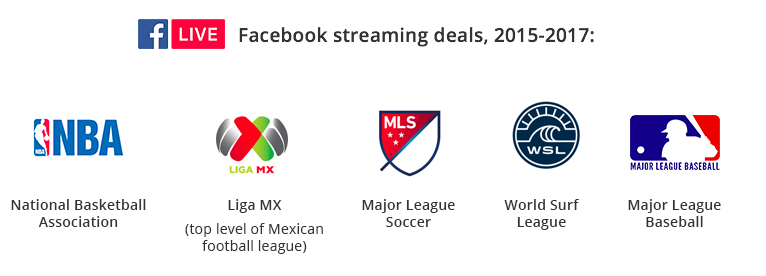
With such a sports streaming strategy in place, it seems there’s really nothing to stop Facebook from becoming the #1 digital sports streaming platform.
Ok, but I don’t have such resources!
Facebook’s plan to create an on-demand platform that will displace traditional TV in terms of sports streaming is ambitious. There are not many companies that could try this and succeed. But even smaller organisations like sport federations, leagues and associations can learn a few lessons.
Here are some tips for you:
First of all – start producing video. It’s the content of today and tomorrow, pretty affordable and will have a huge impact on your fanbase. No matter if you are producing five events per year or your league organises 200 games each season, video is more effective at creating online engagement than any other content type. Every day without video is your loss!
Next – include live video streaming in your marketing strategy. In the sports industry (and any other live-based industry to be honest) being here and now is everything. But you need to bear in mind that your fans aren’t always able to visit the stadium. If your organisation is international, you need to reach out to your global fans. Fans everywhere will want to see your content!
I bet you have plenty to offer your fans – so now tell your story! Use different content types and play with video. Create viral GIFs, best-play compilations, bloopers etc. Don’t limit yourself to the day of your event only – be active all the time, pump up the atmosphere surrounding important games and get involved in your fan community. See how big sports clubs are keeping their fans excited with creative video content here.
Once you start creating and showing your video content, remember that your audience will be watching it everywhere[2]. Literally! If you want to keep them entertained, make your videos mobile-friendly. Especially if you’re focusing on social media, as it’s consumed largely on mobiles. If you want to know more about mobile suited formats, click here.
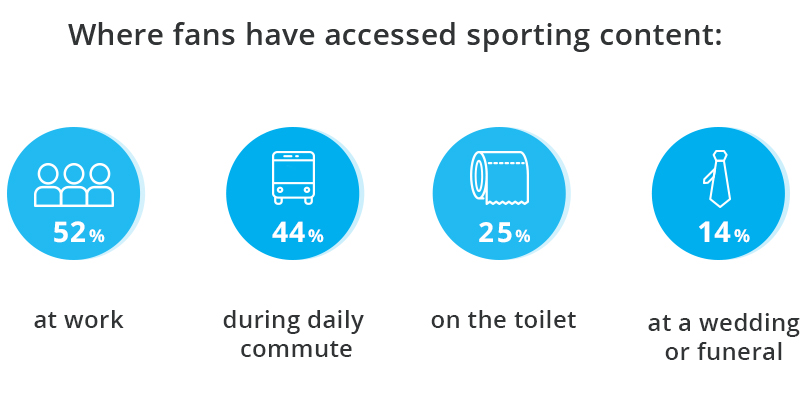
With your own video content and a vibrant community built around your events, club, league or organisation you can finally monetise your productions. Involve your business partners and give them and their branding visibility in your videos. You can easily measure views and the reach of videos – extremely helpful data when negotiating advertising deals. You might create your own on-demand video platform or sell video subscriptions to allow fans around the world to see what you have to offer.
Even if you already have a streaming rights contract, there’s still a lot of stuff you can show – such as interviews with players, press conferences, training sessions or locker room insights. With some creative thinking there will be a plethora of things you can show to your audience. Just try to think outside the usual video-content box!
While not everyone has Facebook’s ambitions and resources, it’s important to realise that an effective video and live streaming strategy is possible to execute for organisations of all sizes and from a range of different industries. And, if you’re going to learn, then learn from the best! Meanwhile, why not consider one of our products – Tellyo Pro or Tellyo On Demand. See what suits your needs the best!
What makes real-time sports videos engaging?
It’s a good question to pose: what does make a real-time sports video engaging? Having worked with the International Table Tennis Federation (ITTF) for a year now, we feel we’ve developed a deeper understanding from what they’ve created and shared through our platform.
In this blog, we’ll take a look at some of the ITTF’s best moments of 2017 – a year that was truly amazing for the organisation, the players and the sport itself. Here at Tellyo, we’re extremely proud to work with the ITTF – the largest international sports federation in the world – to help them distribute such amazing events and historical moments across social media and to thousands of table tennis fans.
Here are their best, most epic video moments of 2017.
Did it hit?
Full of emotion and utterly unpredictable, sport has it all at times. Millimetres can separate players, with even the best referees sometimes struggling to make a call. Here’s what happened during the women’s finals of the ITTF World Cup.
Was the referee’s verdict right? Did the ball hit the table, or miss by millimetres? Watching the above video, we could argue all night long without any satisfactory conclusion; while the video’s comments section is also proof that fans love to watch this kind of content, to debate decisions and make their own call.
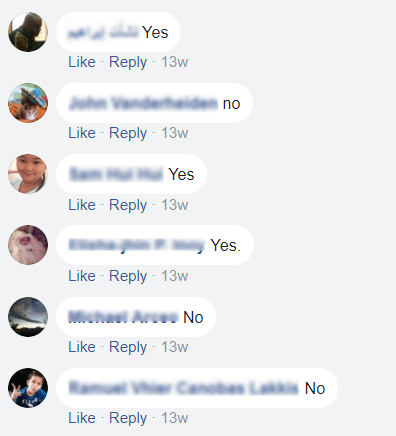
The Did it hit? video reached more than 6 million people, gained 1.3 million views and achieved more than 200 shares! And, just for the record, it was Zhu Yuling who won this amazing game!
The turning point
Every tournament features great personalities and the narrative of an underdog fighting their way to victory. Table tennis is no different. At the 2017 World Table Tennis Championships, the audience was treated to one of the most amazing games in the history of table tennis, ever.
Lin Gaoyuan had a five match points lead against Xu Xin, the world number three. More often than not, the winner would be obvious. But not this time, as Xu Xin kept pressing and won the game point by point, proving that table tennis is one of the most amazing and thrilling sports to watch.
Published on the ITTF’s Facebook page, it was table tennis’s equivalent of the 2005 Champions League Final between Liverpool and Milan. It reached more than 17 million, and achieved 1.7million views and 55,000 engagements, including over 7,000 shares!
Teenagers for the win
Born in 2003, Tomokazu Harimoto is table tennis’s teenage prodigy. Back in August 2017 he won the men’s singles title during ITTF World Tour in the Czech Republic. Aged 14, he became the youngest player ever to win the title, or any similar title, beating much older and more experienced players – something that doesn’t happen very often in professional sports.
Here’s one of the most popular ITTF videos from 2017: Harimoto winning against former Olympic bronze medallist, Jun Mizutani, who was two-times older than Harimoto at the time.
The video of Harimoto’s win reached 1.5 million and achieved almost 300,000 views on Facebook and Twitter.
What have we learned from these epic moments?
Online engagement is triggered by moments that represent the very essence of sport:
- The high emotion of being a sports fan
- Unusual turn of events or controversial decisions that sway matches
- The narrative of underdogs and youngsters defeating those considered to be masters
- Heroes like 14-year-old Harimoto who are quickly taken to people’s hearts
The ITTF videos shared above certainly resonated in some way with audiences – be it through emotion, or the narrative of an underdog or hero – and engagement levels rocketed as a result.
To experience even more epic moments, stay tuned for the upcoming 2018 ITTF Team World Cup being hosted in London.
Maximise great moments in sport, just like the Minnesota Miracle
The 52nd Super Bowl Final hits our screens this weekend. The road to the final has been full of trials and tribulations. Yet, it’s the Minnesota Vikings’ failure to reach Sunday’s game that epitomises the extreme highs and lows of American Football’s annual showpiece.
See other, sports related stories:
- The future of sports fans: what should you expect
- 5 sports clubs keeping fans excited with creative video content
The Vikings’ failure was the ultimate price of their 38-7 loss to the Philadelphia Eagles – a result which only added to the team’s historical playoff woes. Minnesota have now lost six NFC championship play-off games over a 42-season span, causing some to call it a curse.
“There is no damn curse,” said Vikings coach Mike Zimmer to local paper, The Star Tribune.
Yet only a week before the Eagles loss the Vikings were on a high. In a dramatic last-minute moment, they had won their divisional round, defeating the New Orleans Saints 29-24. The stars seemed to align for the Vikings that night. With the game at third-and-10 on the Minnesota 39-yard line and with only 10 seconds on the clock, the Vikings were down 24-23. Yet, somehow, Stefon Diggs pulled off a game-winning touchdown in the dying seconds, causing many to ask: How the hell did the Vikings pull off the Minnesota Miracle?
.@STEFONDIGGS FOR THE WIN!!!!!!!!! #SKOL #NOvsMIN #NFLPlayoffs pic.twitter.com/UAoNJ2NJ97
— NFL (@NFL) January 15, 2018
Diggs’s touchdown was one of those moments in sport that generates pure excitement, something fans all over the world live for. It was also a moment that blew up across social media and generated huge levels of engagement.
How could you maximise such a moment in your sport?
If such a miraculous moment happened in your sport, what would you do? Like the Vikings, how would you amplify it through video content, and help fans everywhere to relive what happened and celebrate your success? Let’s take a look at three aspects of our Tellyo platform that would help.
Multi-camera footage
Tellyo is able to ingest footage from multiple devices – video cameras, smartphones and drones – giving you the option to live stream and share clips from different angles. The Vikings did something similar by sharing footage from their Side Line Cam. Although only from one camera, it added an alternative take on that touchdown (a video short that has since been nominated for a prestigious Shorty Award).
? #MinneapolisMiracle Sideline Cam#BringItHome pic.twitter.com/fRe9CZTlwt
— Minnesota Vikings (@Vikings) January 15, 2018
Live clipping
While the Viking’s clip is undoubtedly awesome, Tellyo’s ability is to take such a clip, mix it with several other angles and publish within minutes of an event happening. The Tellyo video editor puts this level of video production at your fingertips.
In the case of the Vikings, they live clipped and shared the reaction of its player, Everson Griffen, who was simply lost for words. His reaction seemed to sum up the #MinneapolisMiracle.
The #MinneapolisMiracle was so crazy, even @EversonGriffen was lost for words.#BringItHome pic.twitter.com/OXTd9L4pjJ
— Minnesota Vikings (@Vikings) January 16, 2018
Social publishing
As a memorable moment happens, everyone wants to be a part of it. Social media is the place where people want to experience these moments and share them with friends. That’s why Tellyo enables you to publish videos to multiple social media channels simultaneously, with the ability to add messages and hashtags.
The results can be staggering. Once shared, the Vikings’ Cam clip immediately racked up 500,000 views, and has since achieved 8 million total views and counting[1]. The club’s #MinneapolisMiracle social media effort has also generated a whopping 360 million mentions to date!
If you’d like to maximise the moments that matter in your sport, feel free to get in contact with our team to discuss how Tellyo can help.
Local social media to explore – VK in Russia
The internet in 2018 might look like a monolith at times, especially from an English-speaking perspective: Facebook, Netflix, the next iPhone release. However, there’s lots of life outside of this Western mainstream bubble.
So, if you’re planning to target new regions and reach broader global audiences with your video content, you might want to consider what other local solutions and platforms are available to you.
Interested in sports-related topics? Check out our other stories:
- Great sports personalities to follow at the 2018 Winter Olympics in PyeongChang.
- A quick guide to understanding esports and gaming fans.
Here, I would like to introduce you to VK – the main social network in Russia, the 9th most populated country in the world.
In touch with VK
Launched in 2006, VK (VKontakte, which translates as ‘in touch’) is an extremely successful social network. It’s very popular in Russia and some former soviet republics, like Belarus, Kazakhstan and Ukraine, but also receives a noticeable amount of traffic from Germany[1].
VK is ranked as the 11th most popular website in the world, which means it’s more popular than Twitter, Amazon, Instagram or Wikipedia globally. Needless to say, it is number one in Russia and even more popular than the country’s two leading search engines – Russian Yandex and Google!
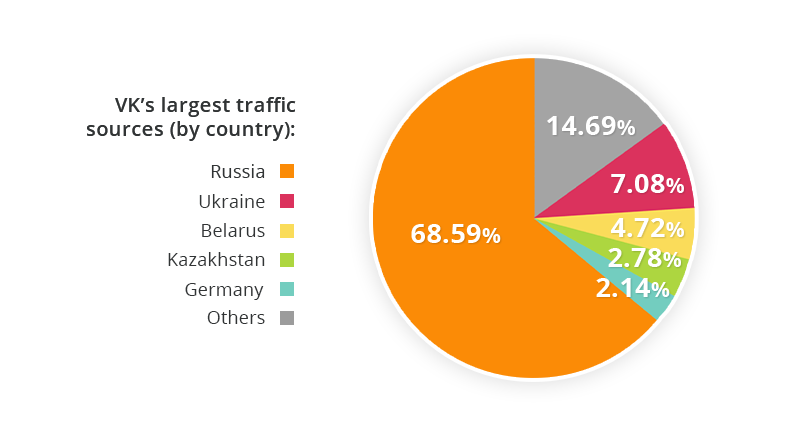
For lots of reasons, VK is often compared to Facebook. Its features are pretty similar to Mark Zuckerberg’s platform. The interface uses a blue colour that Facebook users will be familiar with and overall the functionality is comparable.
VK’s users can publish their thoughts, photos and videos on their profiles, connect with friends and follow communities (like FB groups or profiles). Users are known to consider the network as easier to use and more transparent than Facebook, and that’s probably one of the reasons why VK is more popular in Russia than Facebook.
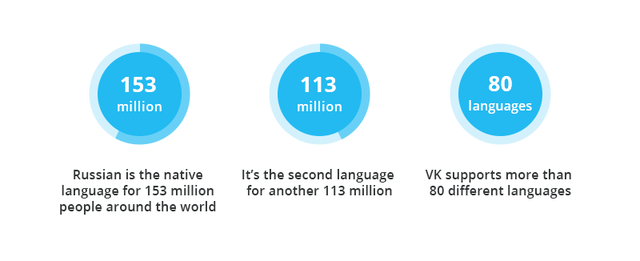
Video hosting is central to VK
VK is widely used as a video hosting platform. Users make the most of VK’s features to share a wide selection of different video types.
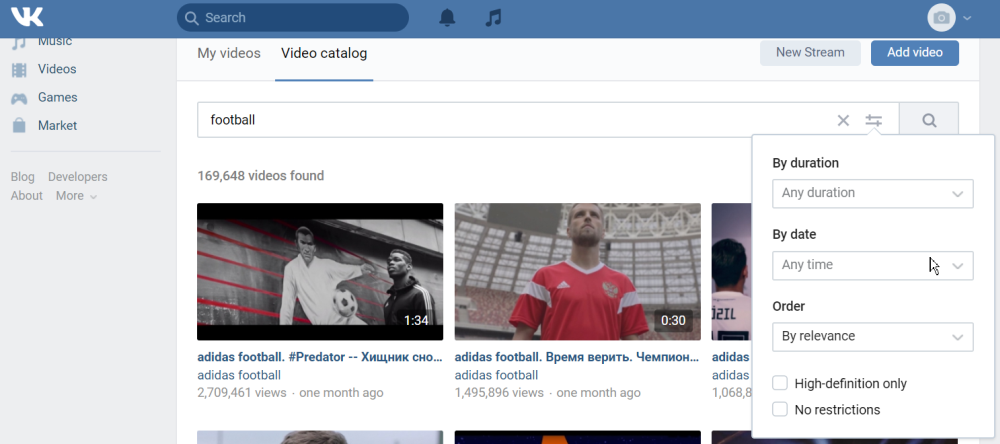
Contrary to Facebook, VK also has a really neat search engine, which is a powerful tool that allows users to search for video content pretty easily, using convenient sets of parameters. Thanks to its search, VK is more akin to YouTube, as you can search through past and present video content with ease.
To picture how big and important the service is in Russia: VK has a bigger monthly audience than any Russian TV station, including the public service, Channel 1[3].
Social media in Russia = VK
VK is full of really strong communities (groups) created around or dedicated to different brands. These groups are created by users in praise of brands. However, the content published within each group is often not in tune with a brand’s own standards. To understand this better, let’s take a look at Nike[4].
Nike on VK
The biggest group dedicated to the brand has more than 1.6million users, while all three of the official Russian Nike profiles have around a third of that amount in total.
The unofficial groups are often used to share content that is interesting to its community and not content controlled by the brand. For example, the biggest VK group called ‘Nike’ is often dominated by game trailers or funny pictures, most unrelated to sports products. This throws up interesting questions about how you might connect with these groups, and influencers could play a vital role here.
The official Nike profiles tend to make use of numerous sets of VK tools to promote the Nike brand, including built-in e-commerce and sponsored content.
For other brands wanting to enter VK, don’t worry as the tools are already there for all to use, ready to help boost the visibility of your brand. Here at Tellyo, our cloud-based video production platform also integrates with VK, enabling you to easily publish video content to the social network.
Other brands on VK
Among other big sports brands present on VK, you can find FC Bayern Munich and Manchester City, but also the NBA, UEFA and dozens of video game titles. There are also many global fashion and beauty brands fighting for the attention of a Russian audience. If there is no official account of a global brand, there will be at least one or two groups dedicated to them.
What’s in it for you?
VK users are very receptive towards big, international brands. Brands can benefit remarkably from being present and active on this Russian social media network, where online communities play a huge role. So, if you’re thinking about developing a greater presence in Russia, then being on VK is a must and key to potential fans and customers noticing your content and brand. And we’re here to help, as our Tellyo platform integrates seamlessly with VK, meaning you can reach audiences on this social channel with real-time video content.
If you’d like to find our more, drop a message to contact@tellyo.com.
Local social media to explore – VK in Russia
The internet in 2018 might look like a monolith at times, especially from an English-speaking perspective: Facebook, Netflix, the next iPhone release. However, there’s lots of life outside of this Western mainstream bubble.
So, if you’re planning to target new regions and reach broader global audiences with your video content, you might want to consider what other local solutions and platforms are available to you.
Interested in sports-related topics? Check out our other stories:
- Great sports personalities to follow at the 2018 Winter Olympics in PyeongChang.
- A quick guide to understanding esports and gaming fans.
Here, I would like to introduce you to VK – the main social network in Russia, the 9th most populated country in the world.
In touch with VK
Launched in 2006, VK (VKontakte, which translates as ‘in touch’) is an extremely successful social network. It’s very popular in Russia and some former soviet republics, like Belarus, Kazakhstan and Ukraine, but also receives a noticeable amount of traffic from Germany[1].
VK is ranked as the 11th most popular website in the world, which means it’s more popular than Twitter, Amazon, Instagram or Wikipedia globally. Needless to say, it is number one in Russia and even more popular than the country’s two leading search engines – Russian Yandex and Google!

For lots of reasons, VK is often compared to Facebook. Its features are pretty similar to Mark Zuckerberg’s platform. The interface uses a blue colour that Facebook users will be familiar with and overall the functionality is comparable.
VK’s users can publish their thoughts, photos and videos on their profiles, connect with friends and follow communities (like FB groups or profiles). Users are known to consider the network as easier to use and more transparent than Facebook, and that’s probably one of the reasons why VK is more popular in Russia than Facebook.

Video hosting is central to VK
VK is widely used as a video hosting platform. Users make the most of VK’s features to share a wide selection of different video types.

Contrary to Facebook, VK also has a really neat search engine, which is a powerful tool that allows users to search for video content pretty easily, using convenient sets of parameters. Thanks to its search, VK is more akin to YouTube, as you can search through past and present video content with ease.
To picture how big and important the service is in Russia: VK has a bigger monthly audience than any Russian TV station, including the public service, Channel 1[3].
Social media in Russia = VK
VK is full of really strong communities (groups) created around or dedicated to different brands. These groups are created by users in praise of brands. However, the content published within each group is often not in tune with a brand’s own standards. To understand this better, let’s take a look at Nike[4].
Nike on VK
The biggest group dedicated to the brand has more than 1.6million users, while all three of the official Russian Nike profiles have around a third of that amount in total.
The unofficial groups are often used to share content that is interesting to its community and not content controlled by the brand. For example, the biggest VK group called ‘Nike’ is often dominated by game trailers or funny pictures, most unrelated to sports products. This throws up interesting questions about how you might connect with these groups, and influencers could play a vital role here.
The official Nike profiles tend to make use of numerous sets of VK tools to promote the Nike brand, including built-in e-commerce and sponsored content.
For other brands wanting to enter VK, don’t worry as the tools are already there for all to use, ready to help boost the visibility of your brand. Here at Tellyo, our cloud-based video production platform also integrates with VK, enabling you to easily publish video content to the social network.
Other brands on VK
Among other big sports brands present on VK, you can find FC Bayern Munich and Manchester City, but also the NBA, UEFA and dozens of video game titles. There are also many global fashion and beauty brands fighting for the attention of a Russian audience. If there is no official account of a global brand, there will be at least one or two groups dedicated to them.
What’s in it for you?
VK users are very receptive towards big, international brands. Brands can benefit remarkably from being present and active on this Russian social media network, where online communities play a huge role. So, if you’re thinking about developing a greater presence in Russia, then being on VK is a must and key to potential fans and customers noticing your content and brand. And we’re here to help, as our Tellyo platform integrates seamlessly with VK, meaning you can reach audiences on this social channel with real-time video content.
If you’d like to find our more, drop a message to contact@tellyo.com.
4 social media platforms for sports video content in 2018
Within the sports industry, everyone from rights holders to broadcasters and sponsors is focusing attention on Facebook, YouTube and Twitter. Justifiably so, as the big three are market leading social media platforms attracting huge audiences, and natural places to find the best streaming and hosting features.
But there’s life beyond these three platforms. Why not consider a different social channel as an ace up your sleeve? Before we delve in to which channels you might choose, let’s explore some background.
The rise of new channels and video
While traditional television has been at the fore of mass sports coverage for years, the world continues to change drastically. The flexibility of the internet has caused havoc in the stiff world of linear TV in recent years. Social media has only deepened a sense of impending crisis.
You may also be interested in the essential read if you’ve ever wondered how to make traditional TV cool again!
One of the latest trends on social media has been the shift towards short, clipped videos – a major point of difference when compared to traditional TV’s long-form formats. It all started with Snapchat, then Instagram and their stories. Nowadays, each social platform favours video – it’s the most engaging and most consumed[1] type of content. So, even if TV is not now number one, video definitely is!
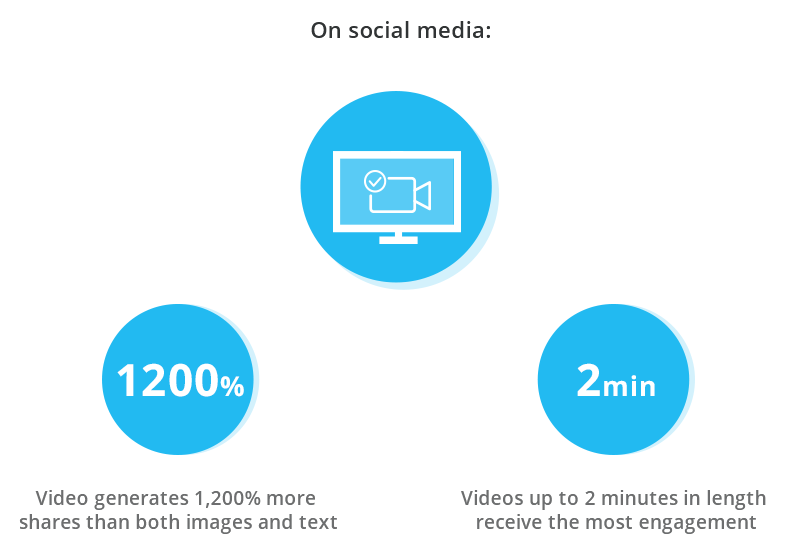
Let’s see what social media platforms are worth checking and considering as a home for your sports video content and more.
Snap that authenticity!
Yes, yes! We all know that Snapchat is extremely popular and that it’s a medium mostly for Gen Zers. While not every brand needs to be there, you should consider it as an option if you’re looking to reach younger audiences.

Snapchat is remarkably well suited to sports. Short, dynamic and unedited sports clips are perfect for this platform that favours ephemeral video content. Short video clips give Snapchat a feeling of freshness and authenticity, which might be easily killed off by the perfect-looking, over-produced clips that you see on Facebook or Twitter.
If you want to try something really cool, check Snapchat Spectacles – digital glasses that can record videos for Snapchat, but also publish them on Facebook, Instagram and YouTube. How cool is that! Check it out yourself:
Insta-everything
You may view Instagram as a place for food and holiday photos and that’s… correct! But this doesn’t mean that you shouldn’t try to bring some of your cool sports videos over to the platform. Especially when Instagram is able to attract a greater mix of audiences that you might want to connect with.
Another positive aspect to Instagram is its own Snapchat-like feature – Instagram Stories – that heavily involves video. While it is Snapchat that brought the video-story format to life, it’s Instagram’s Stories that get better results. Why? Because while Snapchat has die-hard fans that are using the platform for better or worse; Instagram has a couple of huge advantages in a bigger user base and Facebook integration under the hood.
Furthermore, Instagram Stories and its features present videos very professionally, making them look slicker (if that’s what you want). Alongside Stories, you can also publish a varied mix of pictures, raw and spontaneous videos, and professionally produced clips. It’s your call!
Giphy, because we all love GIFs
Not exactly a social network, Giphy is an online database and search engine for animated GIFs. It’s used in one of two ways: users can search for cool animations in an online library, or through third party apps like Facebook Messenger for example.

Giphy is going from strength to strength, recently signing partnerships with big brands to promote content. These partnerships mean that users can now find and use animated GIFs created by Calvin Klein, Disney, General Electric, NASA or Paramount Pictures. As part of the deal, companies get their own profiles on Giphy, which users can search to look for the best GIFs.
Giphy will soon start rolling out sponsored GIFs. According to Techcrunch[5], brands will have the chance to buy a presence in Giphy’s top search results with their branded animations. If you’re a sports brand or broadcaster, this sounds pretty tempting, right?
Tumblr for the brave
The truth is that not every brand fits Tumblr and its spirit. Some say that this pretty well-worn platform is not a good place for brands to be. The reality is complex.
However, Tumblr can be great if your brand has a young audience made up of people who don’t take things too seriously, have a quirky sense of humour and are really open minded.
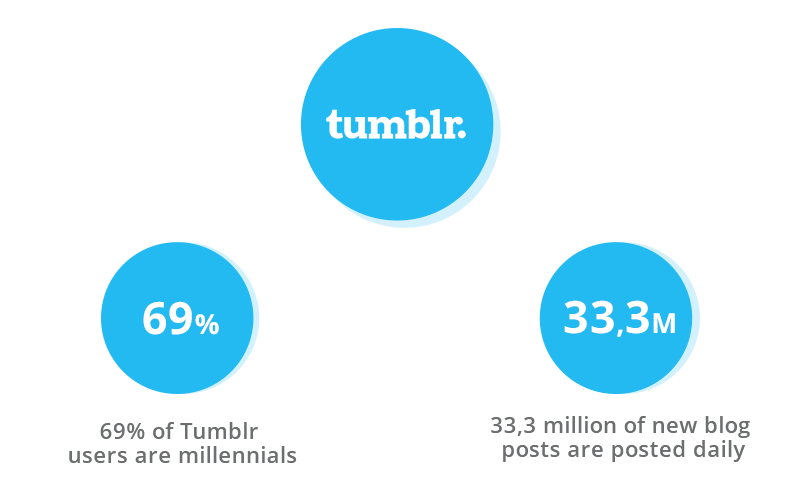
One of the advantages of Tumblr is how it can be used in many different ways. It’s a good for pictures, GIFs and videos, while you can also use it as an effective microblogging platform too. However, most brands keep it strictly for visual content, which can work really well for sports. Check out Vans for compelling extreme sports shots.
Explore lesser known territories
While it’s important to maintain your presence on mainstream social media networks, you should also pay attention to other platforms. Lesser known platforms can offer something different and deliver good gains, such as better visibility when targeting younger demographic groups, like Gen Zers through Snapchat for example.
Besides, with the popularity of short video clips and animated GIFs at a colossal level, it seems a good time to take advantage of the social platforms where these formats are heavily consumed.
A quick guide to understanding esports and gaming fans
Some weeks ago, I presented hard evidence to prove that esports are very promising for broadcasters, especially due to audience growth and the monetisation opportunities available.
Now, it’s time to check who watches digital esports and how they do so to better understand the habits of this group.
A stereotype-busting range of ages
While gaming may sometimes be viewed as a novelty, it has been present in popular culture since way back in the early 70s – back when Pong was released by Atari. Since then, thanks to the rapid development of technology, games are a popular pastime for many people across the globe. And not necessarily just young people.
This is how it looks in the US, regardless of gender:
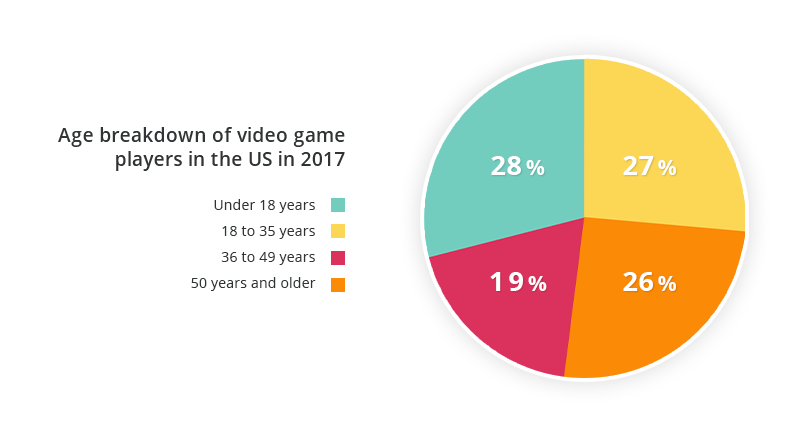
In the above, the 26% of 50+ gamers may remember playing the original Pong, released in pre-internet times and when Richard Nixon was in the Oval office! With almost one-third of players under 18, it looks as though games continue to have a presence throughout someone’s whole life. Most likely, today’s under-18 gamers played their first games on a smartphone or other mobile device however!
Elsewhere, other research has shown that the average gamer is 35 years old – with female players at 37 years old and male ones at 33[2]. These stats alone are enough to make you rethink this audience.
Females play too!
While the common stereotype of a gamer often refers to them as male teenagers or young men, the reality is a bit more complex. Women have a strong presence in gaming communities – 41% of US video game fans are women. This is compared to 59% men across all ages:
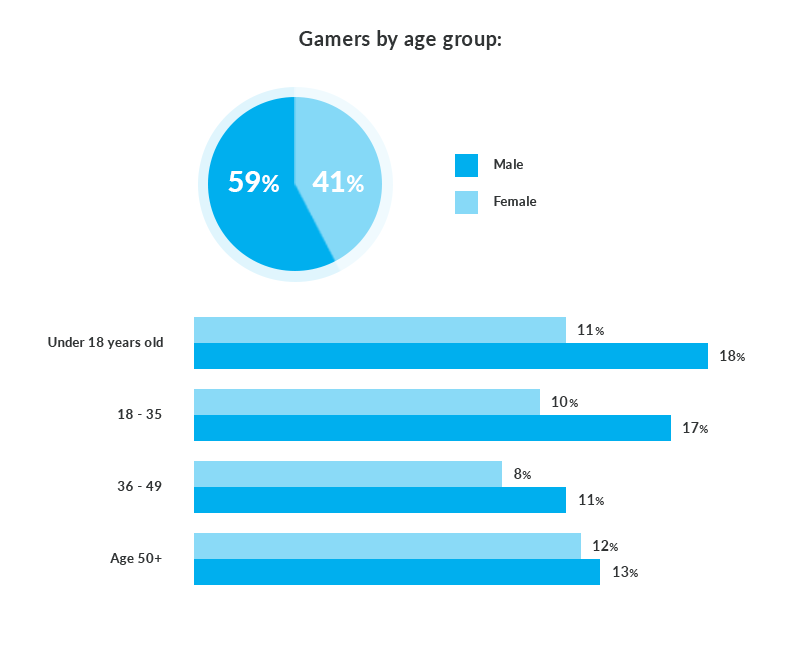
Gaming devices are widespread
In the US, 67% of households own a device that is used to play video games – either a PC, smartphone, wireless device, game console, handheld system or virtual reality device. In 65% of these US households there’s at least one person who plays three or more hours of video games a week. [4]
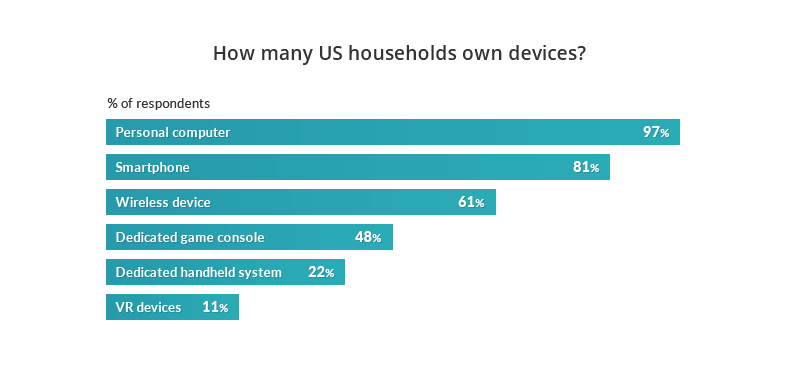
What’s worth a mention here is that gaming devices are very often ‘watching’ devices at the same time. PCs, laptops, smartphones and tablets are multipurpose and very often used as second screens.
To game, or just watch?
There are a lot of similarities between fans of traditional sports and esports. Like this one – that they will often prefer to watch events than actually play the sport (or esport) themselves. According to research by Newzoo, which focused on three of the most popular esports franchises – League of Legends (LoL), Counter-Strike: Global Offensive (CS:GO) and Dota 2 – [bctt tweet=”42% of esports viewers do not play the games they watch.” username=”TellyoTV”]
There are further similarities, with 70% of esports fans surveyed by Newzoo watching only content dedicated to one of the three games mentioned above.
So, how many sports are you following or how many teams do you actively support?
Esports fans aren’t very lavish… yet
The average spend by esports fans on their hobby is $3.64. Another $0.33 should be added as revenue from merchandise, event tickets and subscriptions. All in all, that’s not a great deal of spend, especially bearing in mind the huge prizes available at esports tournaments.
But this rapidly growing market isn’t saturated like traditional sports. For comparison – the average global revenue for a basketball fan is $15 per year, while $54 for all sports.
So, what’s behind such a big difference between esports and traditional sports?
- Esports are popular, but we’re unable to compare their popularity to traditional sports just yet.
- Traditional basketball, football or hockey leagues, for example, are often very well organised. They will have lots of sports events throughout the year and most countries will have their own leagues and cups etc.
- Merchandising in traditional sports is huge, bringing enormous profits to teams, sponsors and partners.
- Youth training systems are often in place for well-established sports – for example, football academies offer more structure for young players.
- Traditional sports get more publicity – their most popular players are pop-culture stars and recognisable around the world.
- Years of tradition – something esports naturally lack for now.
Revenues look to be rising
Average esports revenue per fan is growing and is optimistically forecasted to hit 3 billion dollars globally in 2020. This would count for $11 revenue per fan – which is quite an amount![5]
What’s fuelling such optimistic forecasts regarding future revenues from esports? Let the numbers speak:
- 43% of esports fans in US are earning $75 000 or more annually.
- 31% of esports fans in US have an annual income reaching $90, 000 or more.
According to the same survey, 57% of esports enthusiasts are over 25 years old and live with their children. Can we assume that someday they will pass their passion to younger generations? Well, we can’t foresee this for sure, but it seems pretty plausible[6].
A growing audience
Esports are gaining in popularity very quickly. Some predictions suggest that in 2020 there will be 286 million hard-core, esports enthusiasts and more than 300 million occasional viewers globally. Combining these two figures gives you some idea just how big esports might be in the coming years.
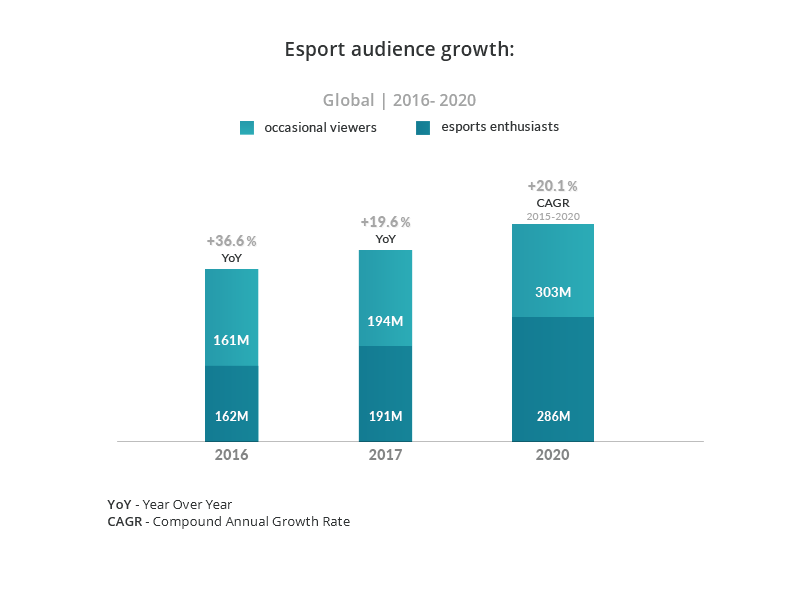
Interesting prospects
Beyond any doubt, esports fans and gamers are interesting prospects now and into the future. They represent a massive audience that brands, broadcasters and rights holders can tap into.
As an audience, esports fans and gamers are:
- Demographically diverse, with some surprising audience segments.
- Like traditional sports fans in the way they are often loyal to only a few favourite titles.
- Rising in numbers, with audience growth continually expanding.
- Limited in ways they can show their support and love for esports with their wallets, besides watching streams and buying and playing games.
As a new type of entertainment, esports are still in a nascent stage – and the world of traditional sports can look saturated in comparison. Esports’ popularity is rapidly growing and there’s still time to jump on the bandwagon before it moves too fast like the flick of a gamer’s thumb.
[1], [2], [3], [4] Source 1,2,3,4
[5] 2017 Global esports market report, Newzoo








